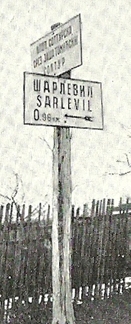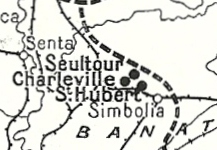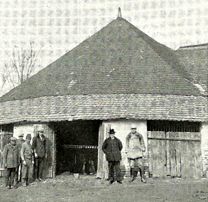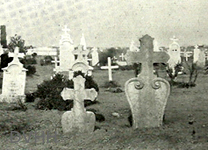|
Villages
Lorrains En
Roumanie |
|
by André Rosambert
Written in the French magazine publication: L'Illustration*,
01 April 1933 -
Issue N. 4700
Translated by
Nick Tullius;
Contributed & Published @
DVHH by
Jody McKim Pharr
- 12 Oct 2010
|
|
|
| |
The church of Saint-Hubert, where until 1840 the sermon was delivered in
French every third Sunday of the month; on the right, the parish house |
|
LORRAINE VILLAGES IN ROMANIA |
|
|
The peace
treaties
integrated
into our
friend and
ally
Yugoslavia
three
villages
with a
population
that almost
completely
has its
origins in
Lorraine.
|

|
|
Border between the villages of Charleville & Seultour |
Situated at
an equal
distance
from the
Hungarian
city of
Szeged and
the Romanian
city of
Timisoara,
on the line
that once
led from
Budapest to
Bazias, the
small towns
of
Saint-Hubert,
Charleville
and Seultour
proudly
carry the
epithet
“Welsch
villages”,
given to
them by
their
neighbours,
the villages
called
“Swabian”,
whose
inhabitants
once
emigrated
from
Germany.
The Middle East has certainly accustomed us to these curious colonisations;
but the
existence of
“French”
agglomerations
along the
Romanian-Yugoslavian
border,
isn’t that
something
unexpected,
and that
among the
newcomers to
the
hospitable
home of the
great
Yugoslavia
we count
brothers of
our race,
isn’t that a
unique turn
of events?
How is it that the travellers that visited this region since Hungarian
times, where
France had
industrial
as well as
financial
interests,
passed quite
close by
these
villages,
without
paying them
the
slightest
attention?1
And how is
it that
since the
armistice,
the detailed
reports from
Yugoslavia,
like those
from
Romania, did
not even
give a hint
about the
existence of
these
distant
compatriots?
For this
abandonment
and
disregard,
regrettable
as they are,
there is an
explanation:
the |
|
Lorraine
villages of
Yugoslavia
are actually
not very
easy to
find, and
when one
finds them,
one must
have studied
them to
understand
their
profound
originality.
Grouped in a triangle at the extreme north-east of the Kingdom of
Yugoslavia,
in a lost
corner of
the Danube
Banat, at 4
kilometres
from Romania
and 50
kilometres
from
Hungary, the
three towns
of
Saint-Hubert,
Charleville
and
Seultour,
even though
they are
located on a
great
railway
line, are
only served
by a little
steam
tramway that
connects the
station of
Sveti Hubert
to the city
of Velika
Kikinda.
And once one enters Saint-Hubert, the most important of the three “sister
communities”
because it
counts 1500
souls,
whereas
Charleville
has 800 and
Seultour
950, one
does not
notice
immediately
a great
difference
between
these
Lorrain
villages and
their
neighbouring
villages,
like Nakovo
or Heufeld,
the
population
of which is
mostly of
German
origin.
That is, for two generations, the descendants of our compatriots, either
from
|

|
|
The three Lorraine villages in the Yugoslavian Banat |
France or
from
then-independent
Lorraine,
immigrated
to the Banat
between 1750
and 1790, no
longer speak
French;
German
became their
usual
language,
and no one
can blame
them.
Attracted to this fertile country by empress Maria-Theresia, whose possessions in
Southern
Germany
(Baden and
Würtemberg)
facilitated
her
recruitment
among the
populations
of Lorraine
and Alsace,
the first
French-speaking
colonists
arrived in
the Banat
with
families
from Germany
and
Luxemburg,
all destined
to
repopulate
the
territories |
|
between
Tisa, Temes
and Danube,
that had
been
devastated
by the
Turks.
Saint-Hubert,
Charleville
and Seultour
were founded
in 1771 by
two hundred
nine
families,
nine out of
ten of which
were
French-speaking.
But on December 6, 1774, an imperial edict imposed the teaching of German
to children
in schools,
and the
systematic
Germanisation
of all
non-German
colonists
(Frenchmen,
Italians,
and
Spaniards)
was a great
preoccupation
of Emperor
Joseph II.
It is in church that French usage was maintained the longest, because the emigrants had
brought
along
missals; the
teaching of
catechism
was in
French for
many more
years and
the sermon
was
delivered in
French every
third Sunday
of the month
until 1840.
The sermon
was
delivered in
French at
the church
in
Saint-Hubert,
for all
three
villages
together, by
priests or
religious
personnel
brought in
from
Temesvar,
headquarters
of the
diocese.
The last inhabitant who spoke French fluently was a farmer named Pierre Hanrio,
who
originated
in Fonteny,
arrived in
Seultour as
a little
child with
the first
colonists,
and died in
1866, nearly
one hundred
years old.
In 1902 when Raymond Recouly, then a young associate, visited the Lorrain
villages of
the Banat
during an
investigation
of
nationalities
and races in
Austro-Hungary,
he still
found an old
woman who
told him
that in her
childhood
she had read
the gospel
in French.
Alas, the Hesse, the Mourgeon, the Hamant, the Colin, the Perrin, the Grosdidier, the
Mathieu, the
Leblanc, the
Georges, had
become Hess,
Muschong,
Hamang,
Kolleng,
Perreng,
Groditje,
Matje,
Leblang,
Schorsch,
did not know
the
sweet
language of
France,
other than a
few rare
expressions.
But it is
wrong and it
would be
unjust to
say, as I
have read in
certain
hasty
reports,
that the
descendants
of our
compatriots
are today
“Germanized”
and have
become
“Swabians.” |
|
A house with
covered
corridor in
Charleville
(1) With
the
exception of
Dr. Louis
Hecht, who
in 1878,
made an
inquiry into
the Alsacian
colonies in
Hungary (Mémoires
de
l’Académie
de Stanislas,
1878. Nancy,
Berger-Levrault,
1879).
|
|
|
|
|
 |
|
A wedding
procession
arriving at
town hall
|
|
|
black eyes
Joseph II commented at
his first trip to the
Banat, made the
inhabitants of the
“sister-villages” so
sympathetic to their
“Swabian” neighbours,
with whom they readily
allied themselves.
Great lovers of music,
they have a famous
choir, conducted by Mr.
Leblanc, an old teacher
from Saint-Hubert, as
well as two orchestras.
The one we listened to,
conducted by the skilful
baton of Mr. Stofflet,
had learnt in only two
days the Lorraine
march, in honour of
their French guest. The
teacher from Seultour
had performed the feat
|
Not the
fantasies
applied by
imperial
civil
servants to
their family
names, not
the mixed
marriages,
nor the
total
abandonment
in which
they were
left until
recently by
their
country of
origin, made
them loose
the memory
of their
ancestral
land.
Is it known that in 1930, the initiative of a farmer whose origins are in
Marsal and
Saraltroff,
author of a
Chronique
of the three
sister
villages,
lead to the
founding in
Saint-Hubert
of a little
Lorrain
museum,
intended to
become the
conservatory
of ancestral
traditions?
Temporarily installed in an agricultural cooperative, a little yellow
building,
with a huge
roof
descending
very low,
very similar
to the
houses of
the village,
the Lorraine
museum of
Saint-Hubert,
whose
founders
gave it the
suggestive
name
“Country
museum”,
comprises a
tiny
antechamber,
a single
room, and a
hangar.
The hangar houses a cart and a plough from the time of emigration.
In the antechamber, on an ancient table with pretty lathe-work legs, Mr.
Nicolas Hess,
founder and
caretaker of
the museum,
placed the
old wooden
measuring
devices once
used in the
village
mills.
Finally, the “main room” of the museum, a little room with earthen floor an
whitewashed
walls,
houses the
treasures
that were
until now
lovingly
preserved in
the
families,
but which
the untiring
dedication
of Mr.
Nicolas Hess
made them
give up, for
the benefit
of the
common good:
clock,
dresser,
chest-dresser,
cabinet with
panels
prettily
decorated
with
flowers, bed
and cradle
naively
painted,
spinning
wheels, an
old butter
churn,
halberd and
lantern of
the night
watchman,
and the
silver-tipped
sticks of
the mayors
of the three
villages, an
Alsatian
waistcoat
with silver
buttons,
etc.
The cabinet
is filled
with
documents,
among which
there are
birth
certificates
issued in |
|
Parroy,
in
Bertrambois,
and a
venerable
French
missal.
In a tray, a Lorraine flag that resembles those that the people of Nancy
and Metz
placed in
their
windows and
which
according to
an order by
king
Alexander
allows the
little
museum, now
a public
museum, to
fly next to
the
tricolour of
our Yugoslav
allies.
|

|
|
The village mill, which dates back to the early time of the colonization |
A gesture by
Mr.
Albert
Lebrun,
whose
goodwill
deeply moved
our friends
from
Saint-Hubert
to have in
their own
museum the
portrait of
the first
magistrate
of the
French
Republic,
wearing his
signature,
alongside
that of
another
great
Lorrainer:
Marshal
Lyautey.
The Lorrainers of Yugoslavia, even though they lost the use of their
ancestral
language,
preserved
many customs
of the
country:
first name
Nicholas
given to
almost all
first-borns;
distribution
of sweets
during
baptisms;
plantation
of the
"May-tree";
rattle on
Good Friday;
use of an
“offering”
at weddings
and
funerals,
some kitchen
recipes,
pies and
Lorraine
flat-cakes;
use of an
old card
game still
called "la
préférence":
all customs
peculiar to
the "Welsch"
Banat
villages and
that one
would seek
in vain in
the
"Swabian"
Villages.
[Translator’s
note:
Contrary to
the author’s
affirmation,
several of
these
customs were
common in
the Swabian
villages of
the Banat].
The
descendants
of our
compatriots
kept to this
day that
virtue of
frugality,
of which the
Lorrainers
were so
justifiably
proud. Their
simple and
natural
joyfulness,
the beauty
of their
women, on
whose
beautiful |
|
of composing
an
orchestral
score from
the text for
piano and
violin that
he had
available.
Music played an important part in all great events. It played its part at
funerals,
the
musicians
marching in
pairs, along
the houses,
with the
rest of the
procession,
while the
hearse
advanced
alone in the
middle of
the 50 to 80
meters wide
streets.
And, during
marriages,
the music
followed the
row of
invited
guests that
moved like a
procession
to the house
of the bride
and groom,
to conduct
them to the
town hall,
then to
church…
Then, after
the dance
that lasted
until dawn,
the young
couple is
conducted to
their home;
it's a last
serenade
which gives
the signal
that the
celebration
is over.
And that is how three thousand descendants of Lorrainers lived, 1400
kilometers
away from
Lorraine.
Their
ancestors
had run away
from the
oppressive
administration
of Mr. de
La
Galaizière:
they had the
good fortune
of finding
in the Banat
a fertile
soil, and
there are no
longer any
poor people
among them.
But their
fate was
even more
favourable
than they
had dared to
hope: their
home is now
incorporated
in the noble
and proud
Yugoslavia,
|

|
|
Graves of Lorraine emigrants
to the Banat |
and it is
under the
banner that
has the same
colours as
ours, good
and loyal
citizens of
a country
dear to all
Frenchmen,
they engage
with joy in
their
peaceful
work in the
fields.
ANDRÉ
ROSAMBERT
(Written in French in
1934)
~ Translated
by Nick
Tullius 2010
|
|
 |
|
The three
Lorraine
villages in
the
Yugoslavian
Banat
[Translated by
Nick Tullius;
Contributed & Published @
DVHH,
Jody McKim Pharr
- 12 Oct 2010]
[Article discovered & contributed by Jody McKim and translated from French to English
by Nick Tullius & Published @ DVHH - 09 Sep 2010 by Jody McKim Pharr.]
L'Illustration
was a weekly French
newspaper published in
Paris. It was founded
by Edouard Charton; the
first issue was
published on March 4,
1843.
In 1891,
L'Illustration
became the first French
newspaper to publish a
photograph, and in 1907,
the first to publish a
color photograph. It
also published Gaston
Leroux' novel Le mystère
de la chambre jaune as a
serial a year before its
1908 release.
During the Second World
War, L'Illustration
was published by Jacques
de Lesdain, a
collaborator; after the
Liberation of Paris, the
newspaper was shut down.
It re-opened in 1945 as
France-Illustration, but
went bankrupt in 1957.
|
|
|
|